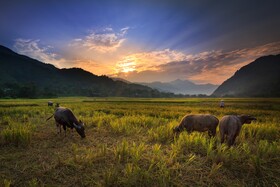


Technology, for example in the form of machines or digitization, should help to feed mankind in the future. Often technology is seen as the only solution, whereby the undesirable side effects caused by technology on our ecosystem are often neglected. As early as 2010, scientists predicted that with our current consumption of resources, space would have to be colonized within the next two centuries. The earth would be used up by then and humanity would otherwise become extinct. Admittedly, this is a rather gloomy scenario, but one cannot deny that technology has its price. Especially when it is used without giving a holistic thought to its effects. Because technology is often used with the aim of wanting to dominate nature; often quick solutions to a problem are sought without considering the long-term implications and costs. A rethink needs to take place here towards long-term planning, which includes undesirable side effects, and away from looking for short-term solutions that are often at the expense of ecosystems.
Burning of land is often done in arid areas to remove dead grass.The effect: new grass can grow back.However, fire does not play a role as a tool in holistic pasture management.Because: If an area is burned down again and again, plants which are growing on it become dependent on the burning process.Burning down on the one hand can lead to biodiversity, but, on the other hand, if burned down on a regular basis, exactly the opposite happens and the species in the landscape become impoverished.The longer plants take to develop, the greater the damage that fire can do.
Often only the short-term successes in burning down are seen, but not the long-term effects of burning down on the ecosystem processes.Even today, around half of the world's pasture areas (750 million hectares) are regularly burned, releasing 3.7 million tons of carbon into the atmosphere.That is, for example, three times more carbon than released by burning forests.In addition, it has negative effects on ecosystem processes, as more bare soil and greater distances between plants are the consequences of burning.
Soils are subject to external influences, be it from animals, machines or weather events such as hail or storm.If a piece of land is free from all external influences, then one speaks of total relaxation.This does not originally occur in nature, as animals normally always have an impact on the soil.
Proper timing is an important factor in recovery tools.For example, herd animals should not return to pasture too early, as this can lead to overgrazing and the ground can be trampled too heavily.However, too long a recovery period can also have negative effects, especially in arid areas.Because in arid areas (8-10 on the scale), total recovery leads to desertification.In non-arid areas (1-3 on the scale), however, the system remains stable with a total recovery, the vegetation simply continues to grow.A partial recovery, i.e. a partial recovery of areas, like total recovery in arid areas, leads to desertification, in non-arid areas it leads to the limitation of the potential of an area.Because: grass plants want to be used.The right amount of time to recover depends on the drought in the area, the climate, the season and the plant species.
There are a number of biological solutions to problems we have in agriculture: biodiversity instead of pesticides;Cultivation systems that combine several plant species instead of monocultures;Compost instead of synthetic fertilizer.In the following some of the biological solutions of the holistic planned grazing are presented.
Animal impacts
Animal impacts include all aspects of the direct physical impact that animals have on a surface.These include the discharge of feces, urine and saliva, rubbing against bushes or trees, as well as trampling and digging.These effects are particularly important in rather arid areas.For example, old plant material is brought to the ground where it can rot more easily;Crop residues are processed by the animals, which then release the nutrients from the residues back into the soil in the form of feces and urine.Animal impacts are therefore an important tool for re-greening arid areas.
Stocking density and herd effect
Stocking density is the number of animals on a certain area in a moment.The higher the stocking density, the more natural the process and the greater the impact on the grasslands.The herd effect relates to the behavior of the animals: a large herd that calmly moves forward eating does not cause a herd effect.The herd effect becomes visible in an emergency situation when the animals are excited.Only then the soil and plant growth will be affected.It can also occur in extremely large herds of between 2,500 and 5,000 animals per hectare.